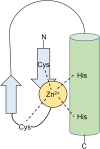Research Progress on the Role of Zinc Finger Protein in Colorectal Cancer
- PMID: 40085529
- PMCID: PMC11908617
- DOI: 10.1002/cnr2.70123
Research Progress on the Role of Zinc Finger Protein in Colorectal Cancer
Abstract
Background: Colorectal cancer is one of the most prevalent malignancies worldwide, with a tendency of increasing incidence in developed countries, which poses a significant threat to the patients' physical and mental health.
Recent findings: The process of gene transcription affects the important physiological functions of cells, so the normal expression of transcription factors is an important prerequisite for maintaining cellular homeostasis. Changes in the level of zinc finger proteins, the most prevalent transcription factor, may play an important trigger for the development of colorectal cancer. Different zinc finger proteins play different roles in terms of promoting or inhibiting cancer development.
Conclusion: This paper briefly reviews the classification, functional characteristics, and expression changes of zinc finger proteins in colorectal cancer, it focuses on how they regulate gene transcription, influence on common signaling pathways, and their potential for translational studies and clinical applications. The objective is to stimulate new ideas for their study of colorectal cancer while also providing foundational information to guide drug development and treatment strategies for colorectal cancer patients in clinical settings.
Keywords: colorectal cancer; mechanism of action; signaling pathway; treatment; zinc finger protein.
© 2025 The Author(s). Cancer Reports published by Wiley Periodicals LLC.
Conflict of interest statement
The authors declare no conflicts of interest.
Figures




Similar articles
-
Zinc Finger Proteins in Colorectal Cancer: Insights into Molecular Mechanisms and Therapeutic Implications.Technol Cancer Res Treat. 2025 Jan-Dec;24:15330338251334447. doi: 10.1177/15330338251334447. Epub 2025 Apr 10. Technol Cancer Res Treat. 2025. PMID: 40208082 Free PMC article. Review.
-
The Roles of Zinc Finger Proteins in Colorectal Cancer.Int J Mol Sci. 2023 Jun 16;24(12):10249. doi: 10.3390/ijms241210249. Int J Mol Sci. 2023. PMID: 37373394 Free PMC article. Review.
-
Somatic human ZBTB7A zinc finger mutations promote cancer progression.Oncogene. 2016 Jun 9;35(23):3071-8. doi: 10.1038/onc.2015.371. Epub 2015 Oct 12. Oncogene. 2016. PMID: 26455326 Free PMC article.
-
Inhibition of zinc finger protein 367 exerts a tumor suppressive role in colorectal cancer by affecting the activation of oncogenic YAP1 signaling.Environ Toxicol. 2021 Nov;36(11):2278-2290. doi: 10.1002/tox.23341. Epub 2021 Aug 5. Environ Toxicol. 2021. PMID: 34351699
-
Zinc Finger-Homeodomain and Mini Zinc Finger proteins are key players in plant growth and responses to environmental stresses.J Exp Bot. 2022 Aug 11;73(14):4662-4673. doi: 10.1093/jxb/erac194. J Exp Bot. 2022. PMID: 35536651 Review.
References
-
- Siegel R. L., Miller K. D., and Jemal A., “Cancer Statistics, 2019,” CA: a Cancer Journal for Clinicians 69, no. 1 (2019): 7–34. - PubMed
-
- Zheng R., Zeng H., Zhang S., et al., “The Epidemiology of Colorectal Cancer in China,” Global Health Journal 2, no. 3 (2018): 8–20.
-
- Qiu L., Hu X., Jing Q., Zeng X., Chan K. M., and Han J., “Mechanism of Cancer: Oncohistones in Action,” Journal of Genetics and Genomics 45, no. 5 (2018): 227–236. - PubMed
-
- Nguyen L. H., Tran T. T., Truong L. T. N., Mai H. H., and Nguyen T. T., “Overcharging of the Zinc Ion in the Structure of the Zinc‐Finger Protein Is Needed for DNA Binding Stability,” Biochemistry 59, no. 13 (2020): 1378–1390. - PubMed
Publication types
MeSH terms
Substances
Grants and funding
LinkOut - more resources
Full Text Sources
Medical

